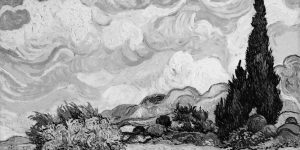What Happened On July 27th?
On July 27, 1890, Vincent Van Gogh, the troubled Dutch painter, walked into the wheat fields he often painted, carrying a revolver. He had borrowed the weapon to scare off birds that threatened his work. However, alone in the fields, he shot himself in the chest. Mortally wounded, he staggered back to the Auberge Ravoux, the inn where he lodged. Collapsing in his small room, Van Gogh lay in agony until the innkeeper discovered him.
Dr. Paul Gachet, a local physician and friend of Van Gogh, arrived quickly. Despite his efforts, he couldn’t save Van Gogh. The bullet had not exited Van Gogh’s body, making it impossible to remove. Van Gogh’s brother Theo, who had provided emotional and financial support, rushed to Auvers upon receiving the news. He found his brother lying in bed, smoking his pipe, and still lucid.
Van Gogh told Theo, “The sadness will last forever,” expressing his enduring despair. After a grueling two days of suffering, Vincent Van Gogh died in the early hours of July 29, 1890, at the age of 37. Theo, devastated by his brother’s death, held him as he passed away.
A Canvas Of Torment
Van Gogh arrived in Auvers-sur-Oise in May 1890, following a stay at the Saint-Paul-de-Mausole asylum in Saint-Rémy-de-Provence. There, he produced some of his most famous works, including “Starry Night.” In Auvers, he sought the care of Dr. Gachet, a homeopathic physician and amateur painter recommended by Van Gogh’s brother, Theo. Gachet’s treatment involved long walks and discussions about art, but Van Gogh’s mental state remained fragile.
Spending his days painting the idyllic landscapes of Auvers, Van Gogh produced around 70 paintings in the last 70 days of his life. Notable works from this period included “Wheatfield with Crows,” often seen as a foreboding piece reflecting his troubled mind, and “Portrait of Dr. Gachet,” which portrayed the physician with an intensity that mirrored Van Gogh’s own turmoil. Van Gogh also painted “The Church at Auvers,” showcasing his affinity for architecture and his emotional connection to the village.

During his time in Auvers, Van Gogh lived in a small attic room at the Auberge Ravoux, which cost him just three and a half francs per day, including meals. The innkeeper’s daughter, Adeline Ravoux, later recounted Van Gogh’s reserved nature and how he spent most of his time working in the fields. She noted his unusual habit of eating paint when he felt particularly distressed, highlighting the depth of his struggles.
The Final Resting Place
Van Gogh’s friends buried him in the municipal cemetery of Auvers-sur-Oise. Only a few friends, including Dr. Gachet and fellow painter Émile Bernard, attended his funeral. They placed yellow flowers, Van Gogh’s favorite, on his casket. Theo, unable to cope with the loss of his brother, fell ill shortly after and died six months later.
Theo’s widow, Johanna van Gogh-Bonger, tirelessly worked to bring Vincent’s work to the public eye. She organized exhibitions and published his letters, revealing the profound thoughts and emotions behind his art. Her efforts gradually shifted public perception, and Van Gogh’s work began to gain the recognition it deserved. Johanna also meticulously preserved Vincent’s letters to Theo, which provided deep insights into the artist’s mind and his relationship with his brother.
Johanna faced significant challenges in promoting Vincent’s work. She moved back to the Netherlands with her young son and a vast collection of Van Gogh’s paintings and drawings. She cataloged and translated Vincent’s letters and actively sought opportunities to exhibit his work. Through her dedication, she managed to sell several pieces, including “The Red Vineyard,” the only painting Vincent sold during his lifetime.
Hidden Strokes
People discovered the small Lefaucheux revolver Van Gogh used in the 1960s in a field near Auvers. This artifact, corroded and broken, symbolized the tragic end of a brilliant yet tormented artist. Van Gogh chose Auvers-sur-Oise because of its reputation as an artist’s haven, previously home to painters like Charles-François Daubigny, whom Van Gogh admired.
Van Gogh’s last painting, “Tree Roots,” continues to interest art historians. Found on his easel after his death, the chaotic tangle of roots and stumps is often seen as a reflection of his mental state in his final moments. Experts identified the exact location depicted in “Tree Roots” only in recent years, revealing Van Gogh’s deep connection to the landscape even in his last days.
Another intriguing detail involves the relationship between Van Gogh and his fellow artists. Although often perceived as a solitary figure, Van Gogh maintained active correspondence with many contemporaries, including Paul Gauguin, Émile Bernard, and Camille Pissarro. These letters reveal his thoughts on their works and his hopes for an artistic community, which he attempted to create in the Yellow House in Arles.
Masterpiece In Sorrow
Van Gogh’s death profoundly affected the art world. His bold use of color, emotive brushwork, and innovative techniques influenced countless artists and movements, from Fauvism to Expressionism. Today, his paintings remain among the most revered and valuable in the world. Works such as “Sunflowers,” “The Starry Night,” and “Irises” are celebrated for their beauty and emotional depth.
The letters between Vincent and Theo offer an intimate glimpse into Van Gogh’s mind, revealing his thoughts on art, life, and his struggles with mental illness. These letters, filled with eloquence and insight, have become an essential part of his legacy, humanizing the artist and shedding light on his profound inner life. They reveal Vincent’s constant battles with his mental health, his financial struggles, and his unyielding passion for his art, despite the lack of recognition during his lifetime.





